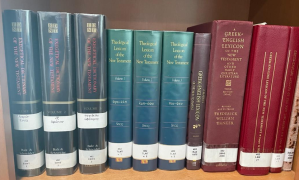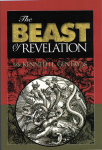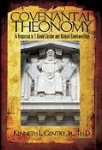NEW LEXICON SUPPORTS PRETERISM!
PMW 2025-052 by Kenneth L. Gentry, Jr.
Introduction
The academic world has recently released a new, updated Greek-English lexicon that is certain to replace the standard lexicons currently in use today. Research in ancient Greek continues unabated at major research universities, with more powerful research tools providing deeper insights into ancient culture and language. And this one will surely displace the universally accepted standard lexicons, such The Liddell-Scott-Jones Lexicon, Thayer’s Greek-English Lexicon, and the Bauer-Danker-Arndt-Gingrich Greek-English Lexicon.
The current batch of Greek-English lexicons has proven helpful to scholars for years. But some academic questions remained as linguistic hurdles impeded fully understanding the Greek, especially New Testament Koine Greek. Now we are witnessing a major upheaval with this publication of the latest, upgraded lexicon, which is invested more strongly in AI-enhanced research.
This new lexicon is called, quite appropriately, New Lexicon of the 21st Century and Beyond. And it certainly will be a tremendous boon for scholars — especially for preterist scholars, as we will see. Plus with the new layout and 100% computer-generated text, the cost of this lexicon will fall well below those currently available — perhaps even 50% less. Let me explain how this can be in this review.
The Lexicon’s first advantage
In the first place, according to the publisher, this lexicon reduced the number of scholars involved in the project. This move helped lower up-front research costs, reduced time consumption, removed unpleasant and disorderly editorial debates, and increased the number of sigla (which itself saved much typographical space).
The Beast of Revelation
by Ken Gentry
A popularly written antidote to dispensational sensationalism and newspaper exegesis. Convincing biblical and historical evidence showing that the Beast was the Roman Emperor Nero Caesar, the first civil persecutor of the Church. The second half of the book shows Revelation’s date of writing, proving its composition as prior to the Fall of Jerusalem in A.D. 70. A thought-provoking treatment of a fascinating and confusing topic.
For more study materials, go to: KennethGentry.com
This new lexicon has become especially important since recent biographical and genealogical research uncovered some unfortunate, long-hidden truths. Most notably, research has discovered that the alleged editors of the standard lexicon of today, were not really Walter Bauer, W. F. Arndt, F. W. Gingrich, and Frederick William Danker, as advertised on the title page. This should have been expected due to the numerous errors that have been troubling Internet chatroom inhabitants of late.
Rather, it has been proven that the editors of BAGD were three men, not four! And their actual names were Mo Howard, Larry Fine (whose real name was Feinberg), and Curly Howard. And despite being Jewish, they were not able to spend an adequate amount of time in research and study of ancient languages and culture (which some consider to be advantageous for developing a lexicon, though such effort may be over-rated and actually cost-ineffective).
In fact, these three editors of BAGD spent most of their time in physical altercations arguing, yelling, slapping, smacking, and poking one another. And these interactions would often result in striking each other with mallets, 2×4 boards, chairs, baseball bats, golf clubs, table legs, doorknobs, broomsticks, mops, phones, pistols, shoes, hats, helmets, belts, rocks, boat oars, machetes, water buckets, ice cubes, a slab of meat, coffee pots, books, plates, sickles, knives, axes, pliers, chisels, crowbars, car jacks, shovels, mallets, pry bars, wrenches, bricks, chains, dumbbells, cue sticks, beer bottles, mallets (as you can see, they often used mallets, hence the reduplication in this listing), radios, saws, screw drivers, and scissors — to name just a few items they weaponized. (Be aware, for research reasons I had to watch 32 hours of Three Stooges shorts to get this list — and it may not even be complete!) These actions caused injuries ranging from minor blemishes to deep wounds caused by severe blows leaving each of them frequently battered and broken. Such actions caused medical costs in the editing process to soar.
In an important televised interview for National Geographic, the grandson of Mo admitted in 1982 that not one of the three editors even realized that our word “alphabet” was simply the combination of the first two letters of the Greek alphabet: alpha and beta. They thought it was just a cute sound that seemed to fit the need if one were asked to talk about the system of written symbols that could represent the sounds of a language, allowing it to represent spoken words in written form. That, and nothing more.

The Book of Revelation Made Easy
(by Ken Gentry)
Helpful introduction to Revelation presenting keys for interpreting. Also provides studies of basic issues in Revelation’s story-line.|
See more study materials at: www.KennethGentry.com
Instead of multiple and fraudulent editorship, only one scholar compiled the New Lexicon of the 21st Century and Beyond. His name is Larry Smith, who for the last three years has been youth pastor of the Momentum Church in Neptune, Tennessee. Momentum Church, as you can tell from its ridiculous name, is a non-denominational congregation (even though it follows the standard marketing practice of contemporary American churches: adopt all Baptist doctrines and practices, and merely drop the name “Baptist” from its sign, which will increase visitorship by almost 8.4%.)
The Lexicon’s second advantage
In the second place, we must notice something significant about this new, updated lexicon: its size. This will surely impress the academic world and speed up technical Greek translation and research. For instance, no longer will scholars be forced to wield and thumb through the Bauer-Arndt-Gingrich-Danker Lexicon’s cumbersome 1108 pages of 7.5 x 12 inch size, set in 7 point font laid out in double columns, and weighing in at a hefty 5 lb. and 6.1 oz. — even in its shrink-wrapped, case bound laminated hardcover edition.
Instead, the New Lexicon of the 21st Century and Beyond will be only 25 pages long, with pages only 5.5 x 8.5 inches in size, surrounded by one inch margins all around, and set in an easy-to-read 20 point Calibri, sans-serif type-font! And five of those pages contained only pictures, with four of those pages showing a different Greek letter expanded to a 7.5 inch height (though not in color, unless you count black as a color). Pastor Smith chose his four favorite Greek letters to exhibit in an enlarged size. The other page showed a picture of Pastor Smith’s two youngest grandchildren, both of whom look kinda Greek (except for their blond hair and blue eyes). What’s not to like about portability and the reduction of muscle strain encouraged by size and weight reduction? But how did they do this for the whole New Testament Greek text?
The Lexicon’s fourth advantage
I will skip to the fourth advantage since I have forgotten the third. In the fourth (and perhaps most important) place, the compiler of this New Lexicon of the 21st Century and Beyond has an advantage on all preceding Greek scholars: he was not encumbered with all the traditional expectations regarding lexical research and analysis. He avoided such by never actually studying Greek. In fact, he never reads books at all, and he does not know history very well. Thus, when he goes to a historical movie, he is always surprised at its ending. When he saw the movie Pearl Harbor, he was as shocked as were the original sailors and airmen on that fateful day.
Instead, Pastor Smith took a much simpler, more up-to-date route: he simply talked with a pastor-friend who knew someone who had visited Greece recently. This allowed him to take a fresh approach which did away with all the alternative entries for each of 5,437 different words in the New Testament. Let me explain.

Covenantal Theonomy
(by Ken Gentry)
A defense of theonomic ethics against a leading Reformed critic. Engages many of the leading objections to theonomy.
See more study materials at: www.KennethGentry.com
No longer must the user of a lexicon have to fumble through page after page of differing definitions and competing applications of the Greek words found in the New Testament: they have all been removed and placed with one-concept definitions that work in every New Testament passage! Think of the time that will be saved as earnest pastors, scholars, and website hosts can now quickly find what they are looking for without expending all the energy, thought, and care previously required.
For instance, the word mello is one Greek word that has been useful for creating a whole new theology, so that we can toss out 2000 years of orthodoxy. Really! One word can be that important! So then, under our sample word mello we read in current lexicons a whole host of definition options — as if people would use the same word in different ways! As a matter of fact, BAGD had under mello the following: “take place at a future point of time, to be subsequent to another event, be about to, be inevitable, be destined, to come in the future.” Not only so, but that lexicon encumbers usability by offering too many research notes proving the point!
But now Pastor Smith’s New Lexicon of the 21st Century and Beyond cuts through all the riff-raff. He notes that all the options for mello signify the same thing: “very soon,” “extremely close at hand,” “incredibly near,” “right now,” “right in front of you,” “why wait?,” “there is no tomorrow,” “relax it has already happened,” “Hey, look at this!”
Conclusion
I would encourage the purchase of this compact but effective lexicon as soon as possible. In fact, I would urge you to buy, purchase, acquire, get, obtain, gain, procure, secure, pick up, barter for, redeem it mello! But be careful to not do it “fast,” for that may not mean “move quickly,” but may mean you will “stick tightly” to something or “go without eating.” Nyuk! nyuk! nyuk!
GOODBIRTH AND THE TWO AGES
I am currently researching a technical study on the concept of the Two Ages in Scripture. This study is not only important for understanding the proper biblical concept of the structure of redemptive history. But it is also absolutely essential for fully grasping the significance of the Disciples’ questions in Matthew 24:3, which spark the Olivet Discourse. This book will be the forerunner to a fuller commentary on the Olivet Discourse in Matthew’s comprehensive presentation. This issue must be dealt with before one can seriously delve into the Discourse itself.
If you would like to support me in my research, I invite you to consider giving a tax-deductible contribution to my research and writing ministry: GoodBirth Ministries. Your help is much appreciated!
Kenneth L. Gentry Jr.'s Blog
- Kenneth L. Gentry Jr.'s profile
- 85 followers



